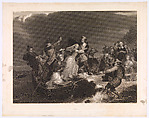The Landing of the Pilgrims at Plymouth Rock, 1620
Engraver Joseph Andrews American
After Peter Frederick Rothermel American
Printer William M. Miller American
Not on view
This print dramatizes the American foundation story of the Pilgrims, religious nonconformists who left England on the Mayflower seeking freedom of worship before establishing the Plymouth Colony in what is now Massachusetts. Based on Rothermel’s painting of 1854, the image shows the group’s military adviser, Myles Standish, standing on a rocky shore, helping his wife, Rose, out of an open boat. All of the men, women, and children correspond to historical individuals who braved the difficult Atlantic crossing in 1620, but, in reality, only men probably disembarked the Mayflower on December 21 to set up camp; furthermore, despite the near mythic status of Plymouth Rock, the group’s exact landing place remains unknown. At upper right, distant Native Americans watch the arrival, reminding us that the land was already peopled.
Due to rights restrictions, this image cannot be enlarged, viewed at full screen, or downloaded.



